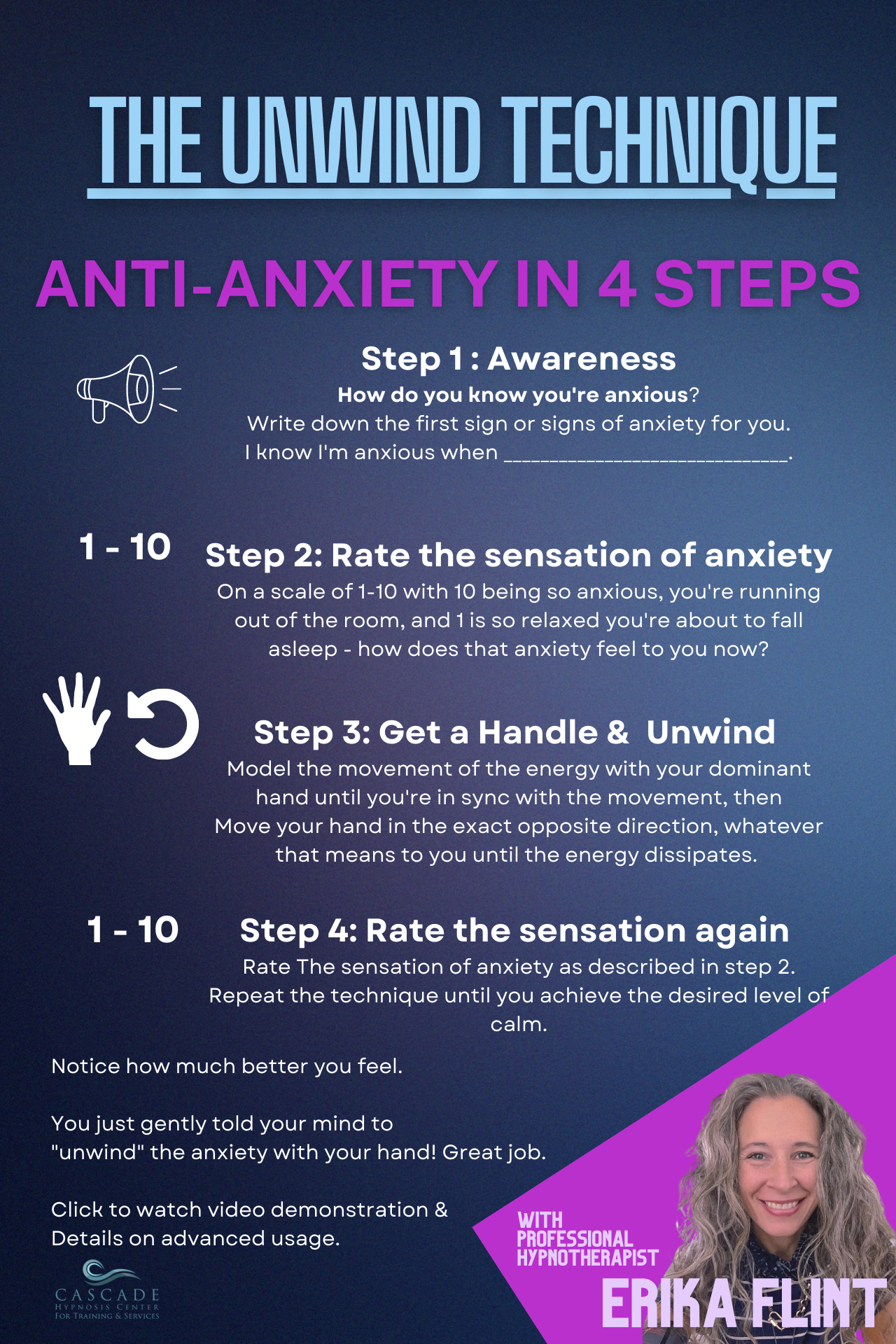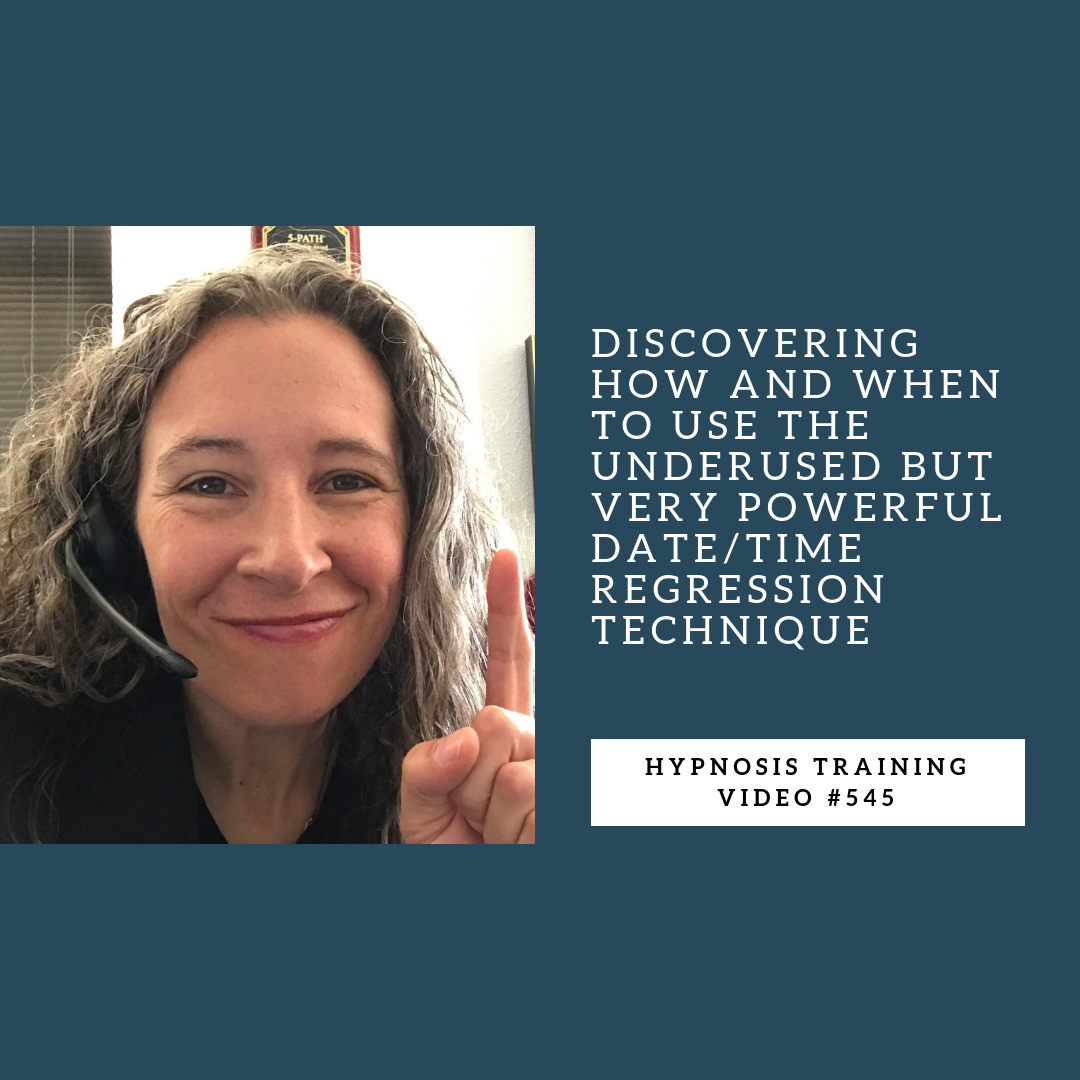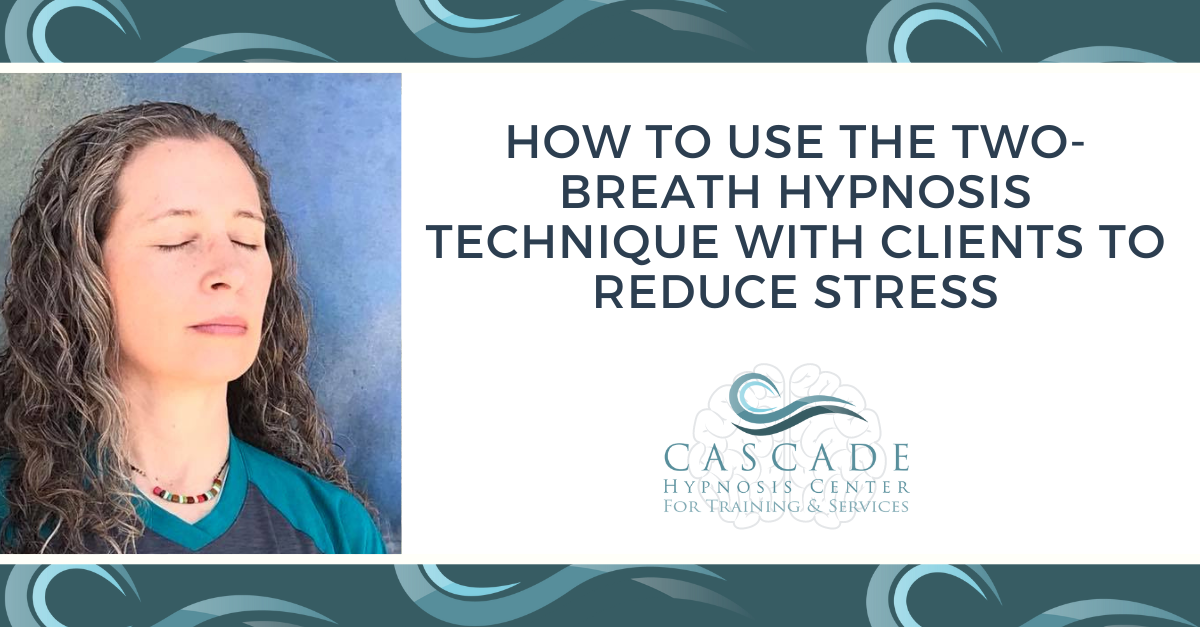The Unwind Technique - 4 Steps to Take Control of Anxiety Quickly and Effectively
In this video, I share one of my favorite techniques that I teach to almost every one of clients called the Unwind Technique, which is used to stay calm in anxiety-inducing situations. It works by diffusing the energy from the body's stress response by bringing attention to the situation with the conscious mind and actively using the body to communicate calmness. It is useful for athletes, musicians, CEOs, public speakers, and anyone experiencing social anxiety.
The technique should be repeated every day, usually several times a day, until you can notice and lower your anxiety instinctively.
If you'd like to change lives by helping people overcome anxiety, and overcome countless personal struggles, you can become a Professional Hypnotherapist in 7 Days! Just visit https://cascadehypnosistraining.com/ for more information.
*The Unwind Technique is based on Backward Spin by Richard Bandler, co-creator of NLP
The Unwind Technique Steps

Step 1: Awareness
How do you know you're anxious?
Write down the first sign or signs of anxiety for you.
I know I'm anxious when _______________________________.
Common sensations include:
- a "butterflies" in the stomach feeling
- sweaty palms
- pressure in head and/or chest
Step 2: Rate the sensation of anxiety
On a scale of 1-10 with 10 being so anxious, you're running out of the room, and 1 is so relaxed you're about to fall asleep - how does that anxiety feel to you now?
Step 3: Get a Handle and Unwind
- Close your eyes. Notice where you feel the sensation of anxiety in your body.
- With your dominant hand, move your hand in rhythm with the sensation of anxiety. Mimic the movement of that energy in your body.
- Once you have a "Handle" on it - move your hand in the exact opposite direction - whatever that means to you, until the sensation dissipates.
Step 4: Rate The sensation of Anxiety Again
Rate The sensation of anxiety as described in step 2. Repeat the technique until you achieve the desired level of calm.
Video Transcription:
Hello, welcome. I am Erika Flint, professional hypnotherapy instructor and hypnotist, and this is one of my very favorite techniques that I teach to nearly every one of my clients. So I want to have a video of it as well. This is called the Unwind Technique, and it's traditionally used in an anti-anxiety or an acute anti-anxiety situation.
And what I mean by that is you're starting to feel a little anxious. You're feeling. And what do you do? You don't like feeling that way. We usually don't like feeling that way. So this is a very effective and powerful mind body technique. And the reason that it works is we start speaking directly to the body.
Okay. All right. So why is it useful? It's highly effective. It's a highly effective way of talking to the body to stay calm in most situations that you want to. We can't stay calm all of the time, but most of the time we are able to, especially in situations, school work, dealing with difficult people; things that just naturally make us anxious.
We are able to use this technique to stay calm. So how does it work? It uses the mind-body connection. Energy stresses, energy from the body here to meet a challenge. So if you're thinking of something stressful, we're reminded of something stressful, we start to get a little anxious. The brain thinks, oh my gosh.
Let me give you some energy to solve that problem, but we just experience it as anxiety. So the way that this technique works is twofold. First of all, we bring attention to the situation with our conscious mind, and that alone diffuses some of the energy because now we are, we have some of our brain focusing on the situation, and the second reason that it works is we're actively using our body. So we're gonna be using our hands in this situation to communicate to our body what we want. So who is it for? It's for anybody who wants to be an excellent performer. So an athlete, a musician, a CEO, a public speaker.
The primary reason that I'm using it now is just for people who are experiencing social anxiety and they're just feeling anxious, right? When they leave the house, when they're talking to people, there's just a level of anxiety that they don't like. So this is excellent. In both of those cases, whether it is performance related or you're just feeling really anxious, both cases.
All right. So we're gonna go through the technique now. Step one is awareness. How do you know you're anxious? This is probably the most important. A lot of us will just, we just continue to feel anxious, but we might not know the very first sign. So take a moment right now. How do you know that you're anxious?
The very first sign we want to catch anxiety. When it is at its lowest level, its lowest potential energy. So for me, I feel a little bit of butterflies in my stomach, but some people feel like a warmth in their hands. They might feel something in their chest. So just make note of right now, how do you know that you're anxious?
Okay. All right, so step two is I want you to rate your anxiety and in the hypnosis office, when you do this with your hypnotist, they're probably gonna ask you to bring up something that makes you a little bit nervous, and this is why. So we want you to bring up just a little bit of anxiety, like you're stuck in traffic, something like that, and bring up that anxiety probably to a level five or above. Now, this is really useful for us because we get to see how much has shifted when you do this technique. So you really wanna do this every time if you can. Okay? So what is your, an level of anxiety on a scale of one to 10, with 10 being so anxious, you're about ready to run out of the room. Now the next step.
Step three is I want you to close your eyes and I want you to notice where you feel a sensation of energy in your body. Most people feel it in the chest. Sometimes they feel pressure, but the idea is that this anxiety is energy. It's energy, and so close your eyes, get a handle on that energy.
Just mimic how it feels like it's moving in your body with your hand. Okay. So to me it's kind of like, it's a jittery, like this. Okay. That's how it feels. If I'm feeling nervous inside. That's how I would represent that with my hand. And yours might be like this, other people's is kind of like.
It's all right. It's, however the energy feels like it's moving in your body. So that's what we call it, getting a handle. You get in rhythm with that feeling. And then what I want you to do, this is the magic. I want you to unwind it, move your hand in the exact opposite direction. and the body will listen to you.
The body will listen and it will calm down. You've effectively just told your body, Hey, we don't really want that energy for this right now. Let's unwind it. So you were using the body to talk to the body. Good job. Good job. Now the next step is to once again rate your anxiety or rate your perception of anxiety.
Hopefully it's gone. . If it's gone down three or more points, awesome. We usually leave it like that. If it's only gone down one, then do it again. Do it again. You are retraining your mind for calm. And so the idea is that we want to starve your mind of any anxiety whatsoever. Any time you start to feel even the littlest bit of anxiousness, I want you to use this technique.
Okay? We want to starve the brain of anxiety. So whenever you feel this right, use this unwind technique. And a lot of my clients will be using this 10 times the first day, 10 times the next day, and then eight times. Four times, three times. And don't be surprised that you might do it 15 times in the first day.
Good for you for noticing. And every time you unwind that anxiety using this technique, you will feel calmer and you will feel better. Okay? You should feel calmer and more relaxed. Over the course of a couple of weeks, you will notice an increased ability to remain calm overall, so you should feel more settled, not as jumpy.
You should feel more secure, and this is just we're retraining the brain so that you're spending more of your time in a calm focused state or a calm, relaxed state than an anxious. some of the advanced options after you do this technique for a while. Let's say your anxiety feels like this at first and you unwind it, right?
You're not gonna wanna do that in a front of a bunch of people probably, and I want you to know that over time you can start using smaller and smaller movements. As a matter of fact, the next smallest movement that I usually recommend for my clients is just using their fingers. So just imagine that you're unwinding that anxiety with your fingers like this.
Okay? We could usually do that after a couple weeks of practice because we've conditioned ourselves to the actual unwind. Okay. And then, like I said, here, you can use your fingers and over time you can just imagine it in your mind. So that's how I do it. Now. I don't have to use my body anymore, but I still get anxious.
And when I do, I imagine that I am unwinding it in my mind. Isn't the mind fantastic? Yeah. This is easy to practice on your own and this is how I recommend it, right? You're sitting at home, maybe you're on social media, you're listening to the news, whatever it is. If you start to get a little bit anxious, do the unwind technique right then and there, and then do it again.
Just do it anytime that you feel a little bit of anxiety, but I find it particularly useful when you're at home because there's nobody else around and you can continue doing this unwind technique. When you hear something on the news or you read something in the paper that kind of triggers you a little way.
So we get to practice this at home, and then when we get out into the world and somebody says something your boss is mean again, whatever it is. Now the technique is all ready to go now. It's all ready to go, and you are able to stay clear headed, no knee jerk reactions, and you get to stay calm and in the present moment, feeling like you're really fully engaged and enjoying your life.
Once again, here are the techniques. Here's the four steps. Step one is awareness. How do you know you're anxious? Awareness is almost always the first step in any change we want to make. We have to be aware of what things are currently, so you're gonna get really good at noticing when you're anxious so that you can turn it down, turn it down, turn it down, turn it down, turn it down, turn it down, turn it down.
Step two, rate your anxiety. A scale of one to 10. This helps us notice the shifts and the change. It's good for the conscious mind, makes us feel good that we're doing good work. Number three, get that handle. This is the important part. So really get a sense of how that energy is moving in your body. It's different for every person, but once you are locked into that, then you're gonna move it in the exact opposite direction.
And then you'll notice that your body calms down and you don't have that anxious feeling anymore. And again, rate your anxiety after that. Now, I do recommend keeping a journal of this. It is helpful for you and I look forward to hearing about your results. Leave any questions to the post below. I'll be sure to answer them.
And thank you for joining me for this discussion on the Unwind Technique, I’m Erika Flint. Bye for now.


